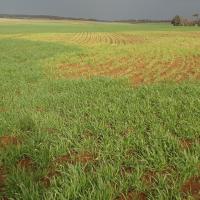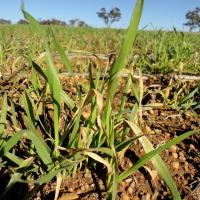Diagnosing manganese deficiency in oats
Oats are very susceptible to manganese (Mn) deficiency, which produces a condition called 'grey speck'.
What to look for
- Manganese deficiency often appears as patches of pale, floppy plants in an otherwise green healthy crop.
Paddock
- Initially, middle leaves are affected first, but it can be difficult to determine which leaves are most affected as symptoms rapidly spread to other leaves and the growing point.
- Plants become pale green. Small linear grey flecks appear on interveinal tissue in the basal half of old leaves, extending towards the tip as symptoms develop.
- Flecks often join to form large lesions in the basal half of the leaf between the margin and mid vein, eventually affecting the vein. Leaves often kink, collapse and eventually die giving plants a wilted appearance.
- Tillering is reduced, with extensive leaf and tiller death. With extended deficiency, the plant may die.
- Surviving plants produce fewer and smaller heads.
Plant
What else could it be
| Condition | Similarities | Differences |
|---|---|---|
| Diagnosing nitrogen deficiency in oats | Pale plants | No wilting, leaf kinking, grey lesions |
| Diagnosing waterlogging and salinity in oats | Pale plants | No grey lesions or leaf kink |
| Diagnosing iron deficiency in cereals | Pale plants | New leaves affected first |
| Diagnosing sulphur deficiency in cereals | Pale plants | New leaves are affected first |
Where does it occur?

Spraying herbicide

Soil ph

Soil type
- Deficiency tends to occur on coastal alkaline soils and high PRI, water repellent gravels associated with wandoo powderbark wandoo, brown and blue mallet and blue mallee vegetation.
- This occurs in an area south of Moora to Katanning and east from Corrigin to Dumbleyung, and infrequently on the Esperance sandplain and mallee area north of Esperance.
- Manganese deficiency is exacerbated by dry soil, high soil pH, lime applications and root pruning herbicides (particularly groups A and B).
Management strategies

Spraying foliar

Top dressing
- A foliar spray will correct the deficiency, but a repeat spray a few weeks later may be necessary.
- Acidifying ammonium nitrogen fertilisers can reduce manganese deficiency by lowering pH and making manganese more available to growing crops.
- Manganese fertiliser is effective but expensive as high rates and several applications are required to generate residual value.
- Seed manganese coating treatments have little effect in correcting the deficiency.
How can it be monitored?

Tissue test
- A whole-top plant test of 20mg/kg gives a rough indication of deficiency. The concentrations of Mn in tissues vary for different oat varieties.
- Compare paired good/poor plant samples where possible.
- There is no reliable soil test for manganese in cereals. As soil test manganese is generally poorly related to grain yield increase, a critical concentrations can't be determined.
Where to go for expert help
Page last updated: Friday, 19 February 2016 - 2:00pm




